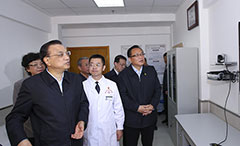Medical reforms undertaken this year
2017-10-08
english.gov.cn
In the government report presented in March, Premier Li Keqiang pledged to carry forward medical reform during the year 2017. As of the end of September, most of the policies had been implemented, influencing every aspect of people’s life.
Direct settlement for cross-regional medical fee
A nationwide settlement network for cross-regional medical treatment has been established, according to the Ministry of Human Resources and Social Security. By Sept 25, 7,226 designated medical institutions have launched cross-provincial medical care service.
People can now register at the local medical insurance management units, and benefit from the direct settlement of medical costs if they received treatment in other provinces’ designated hospitals.
In addition, a new type of rural cooperative medical care system for intra-provincial medical fees settlement has covered nine provinces by the end of August, involving 150 million people in rural areas, according to the National Health and Family Planning Commission.
Tiered medical system boosted
The State Council decided to set up more medical treatment partnerships among big hospitals and grassroots medical centers, according to a circular released in April.
This move is aimed at establishing a tiered medical system, which encourages people to see doctors at basic-level hospitals with indisposition, large hospitals with severe illness, and undergo rehabilitation back at basic-level hospitals.
At present, about 80 percent of the third-level hospitals have established a tiered medical system.
China is also to expand contract-based family doctor services to 85 percent of prefecture-level cities. The contract rate for family doctors among key groups is set to reach above 60 percent in 2017.
More medicines, lower prices
Public hospitals were required to remove medicine markups before Sept 30, and were prohibited generating profits from medical examination and test. The average increase of medical care fees over the year is to be capped under 10 percent.
In addition, once high-priced and rigidly demanded, 36 medicines were included into medical insurance coverage, with average price reduced by 44 percent compared with 2016.
Moreover, big data will be used to monitor medicine shortage to guarantee supply.
A simplified invoicing mechanism has been carried out in 11 medical reform pilot zones, which only requires two invoices from medicine production to circulation enterprises and then to hospitals, meaning more transparent pricing and cheaper medicine for patients.
Diversified payments for different illness
The State Council decided to roll out a diversified medical care payment in line with different illness in 2017, according to a circular issued in June.
The payment, classified into hospitalization, treatment at basic-level hospitals, and diagnosis fees, will facilitate a more regulated medical charges.
Medical insurance subsidy increased
In 2017, the annual average medical insurance subsidy from financial departments will be increased by 30 yuan per capita from 420 yuan to 450 yuan.
In addition, the state subsidy for basic public health services is to be raised from 45 yuan to 50 yuan.
Other changes in medical insurance
Basic medical insurance and maternity insurance will be merged in 12 cities as pilot projects, including Handan in Hebei province and Jinzhong in Shanxi province, according to a circular released by the State Council in January.
Critical illness insurance will be improved to lift patients’ burden, with more favorable subsidy to poor families.
Local governments are required to increase the reimbursement ratio. The poor in county-level regions can receive treatment before payment.


